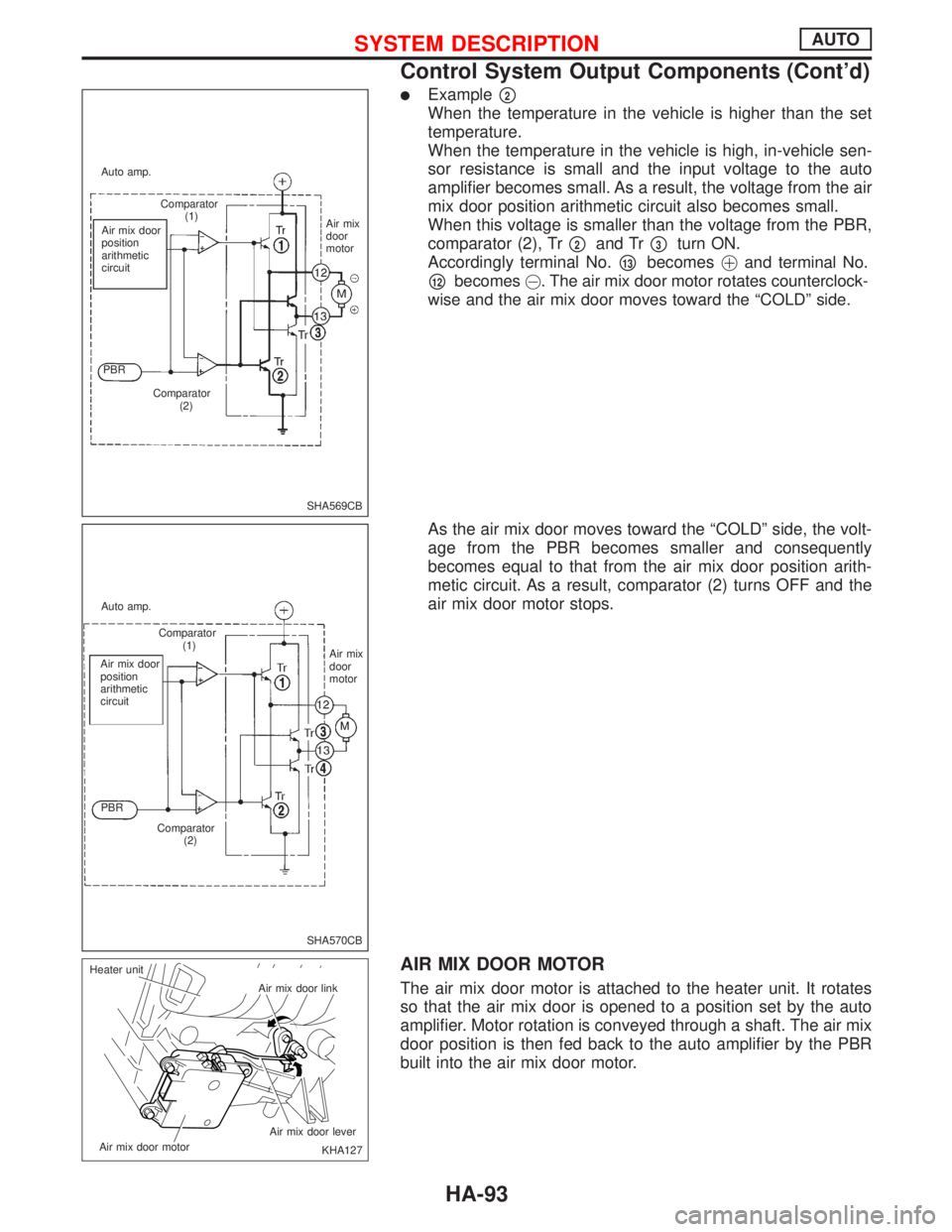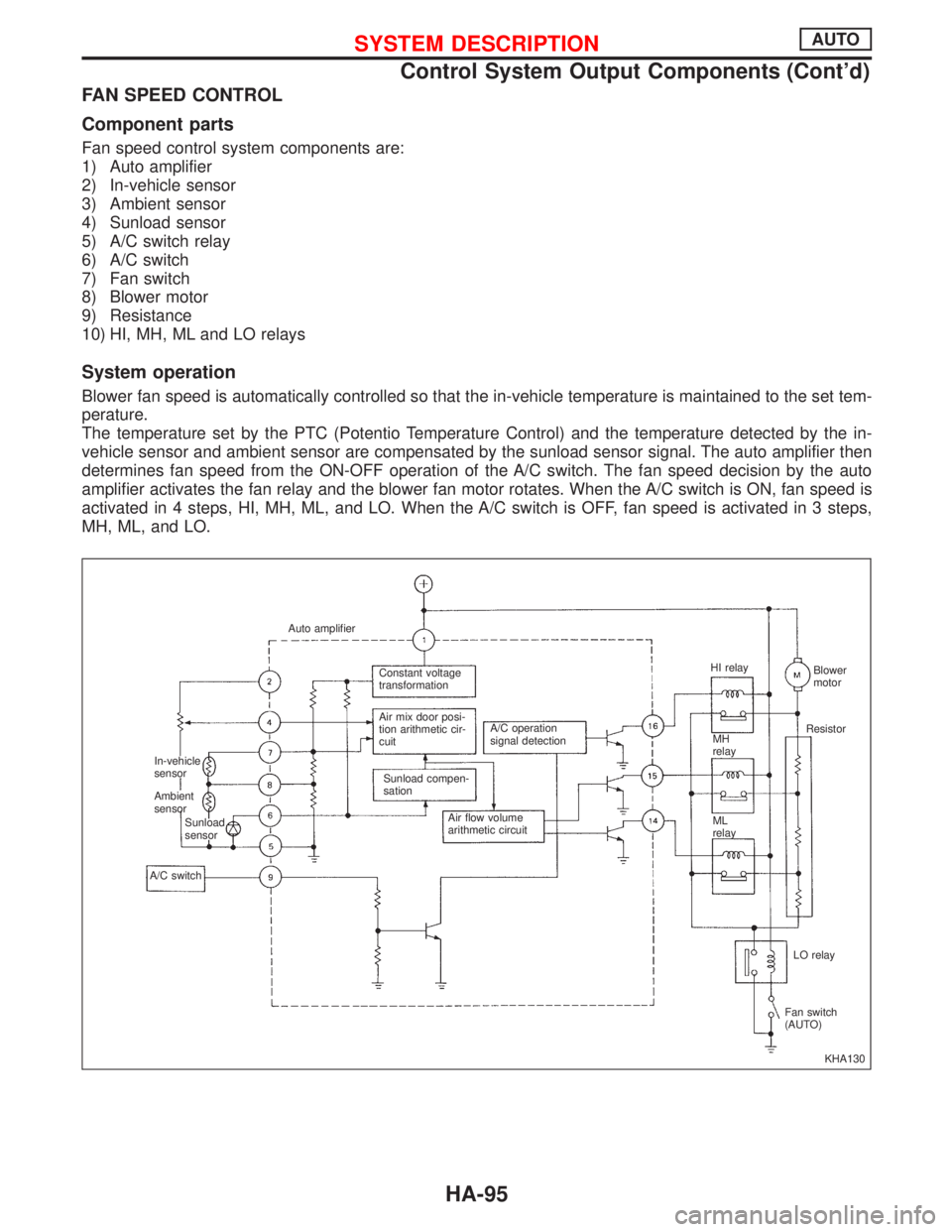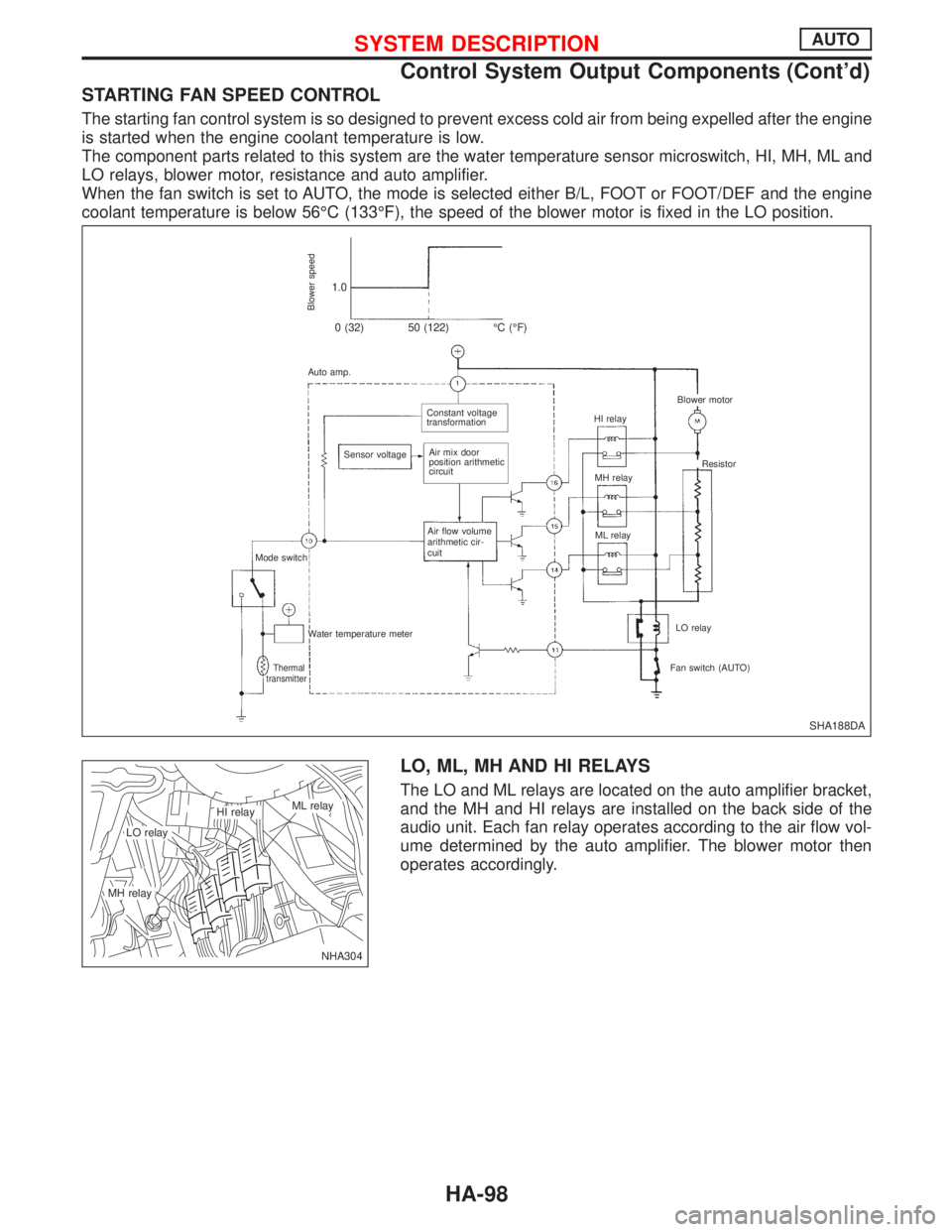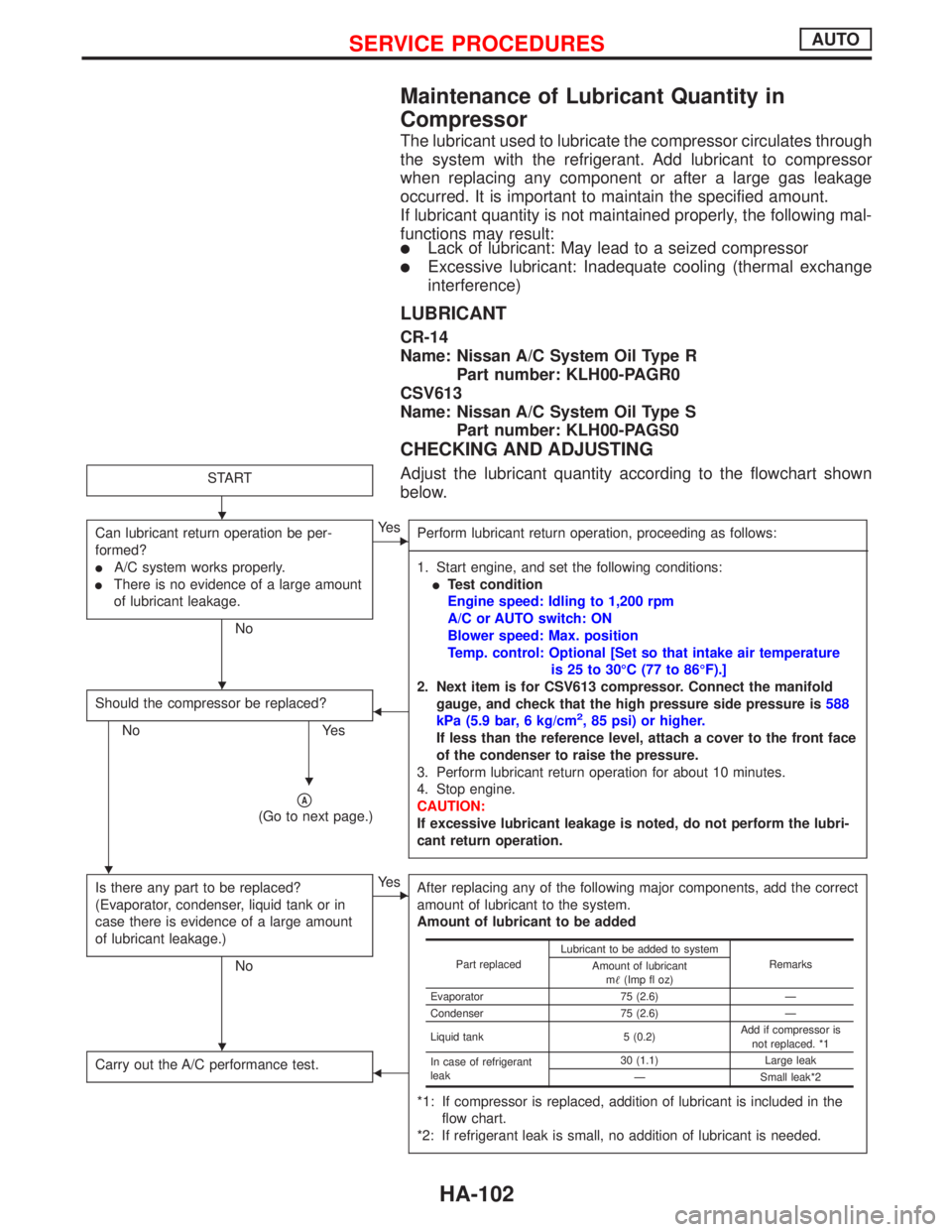Page 1942 of 2267

lExamplep2
When the temperature in the vehicle is higher than the set
temperature.
When the temperature in the vehicle is high, in-vehicle sen-
sor resistance is small and the input voltage to the auto
amplifier becomes small. As a result, the voltage from the air
mix door position arithmetic circuit also becomes small.
When this voltage is smaller than the voltage from the PBR,
comparator (2), Tr
p2and Trp3turn ON.
Accordingly terminal No.
p13becomes!and terminal No.
p12becomes@. The air mix door motor rotates counterclock-
wise and the air mix door moves toward the ªCOLDº side.
As the air mix door moves toward the ªCOLDº side, the volt-
age from the PBR becomes smaller and consequently
becomes equal to that from the air mix door position arith-
metic circuit. As a result, comparator (2) turns OFF and the
air mix door motor stops.
AIR MIX DOOR MOTOR
The air mix door motor is attached to the heater unit. It rotates
so that the air mix door is opened to a position set by the auto
amplifier. Motor rotation is conveyed through a shaft. The air mix
door position is then fed back to the auto amplifier by the PBR
built into the air mix door motor.
SHA569CB Auto amp.
Comparator
(1)
Air mix door
position
arithmetic
circuit
PBR
Comparator
(2)Air mix
door
motor
SHA570CB Auto amp.
Comparator
(1)
Air mix door
position
arithmetic
circuit
PBR
Comparator
(2)Air mix
door
motor
KHA127 Air mix door link
Air mix door lever
Air mix door motor Heater unit
SYSTEM DESCRIPTIONAUTO
Control System Output Components (Cont'd)
HA-93
Page 1943 of 2267
21Air mix door
operationDirection of lever movement
!@COLD,HOTClockwise
(Toward passenger compartment)
Ð Ð STOPSTOP
@
!HOT,COLDCounterclockwise
(Toward engine compartment)
PBR
Measure voltage between terminalsp3andp4at vehicle har-
ness side.
Ignition switch: ON
lEnsure tester pointer deflects smoothly when PTC is moved
from 18ÉC (64ÉF) to 32ÉC (90ÉF) and vice versa.
RHA026H Air mix door motor
connector
M413
(HOT
side)(Cold
side)
PBR
KHA129 Characteristic PBR
Resistance of PBR (W)
(resistance between terminal
p4and
p3)
.3.0
2.5
2.0
1.5
1.0
0.5
COLD Air mix door opening angle HOT60É
NHA311 Air mix door motor
RHA607AA
Voltage (V)
Full cold Full hot
Air mix door opening angle PBR
specification5.0
4.0
3.0
2.0
1.0
0
SYSTEM DESCRIPTIONAUTO
Control System Output Components (Cont'd)
HA-94
Page 1944 of 2267

FAN SPEED CONTROL
Component parts
Fan speed control system components are:
1) Auto amplifier
2) In-vehicle sensor
3) Ambient sensor
4) Sunload sensor
5) A/C switch relay
6) A/C switch
7) Fan switch
8) Blower motor
9) Resistance
10) HI, MH, ML and LO relays
System operation
Blower fan speed is automatically controlled so that the in-vehicle temperature is maintained to the set tem-
perature.
The temperature set by the PTC (Potentio Temperature Control) and the temperature detected by the in-
vehicle sensor and ambient sensor are compensated by the sunload sensor signal. The auto amplifier then
determines fan speed from the ON-OFF operation of the A/C switch. The fan speed decision by the auto
amplifier activates the fan relay and the blower fan motor rotates. When the A/C switch is ON, fan speed is
activated in 4 steps, HI, MH, ML, and LO. When the A/C switch is OFF, fan speed is activated in 3 steps,
MH, ML, and LO.
KHA130 Auto amplifier
In-vehicle
sensor
Ambient
sensor
Sunload
sensor
A/C switchConstant voltage
transformation
Air mix door posi-
tion arithmetic cir-
cuit
Sunload compen-
sationA/C operation
signal detection
Air flow volume
arithmetic circuitHI relay
MH
relay
ML
relayBlower
motor
Resistor
LO relay
Fan switch
(AUTO)
SYSTEM DESCRIPTIONAUTO
Control System Output Components (Cont'd)
HA-95
Page 1945 of 2267
Signals from each sensor, PTC, A/C switch etc. are sent to the
air flow volume arithmetic circuit in the auto amplifier. Air flow
volume is determined by this circuit.
(1) When the air flow volume is set to ML
The air flow volume arithmetic circuit gives current to Tr
p3,
which turns the ML relay on. Thus, the blower motor rotates
in the ML condition.
SHA573CC
SHA574CA
Air flows
volume
arithmetic
circuitHI
relay
MH relay
ML relayBlower
motor
Resistor
Fan switch
(AUTO)
A/C (LO) relay
SYSTEM DESCRIPTIONAUTO
Control System Output Components (Cont'd)
HA-96
Page 1946 of 2267
(2) When set to HI
The air flow volume arithmetic circuit gives current to Tr
p1,
which turns the HI relay on. Thus, the blower motor rotates
in the HI condition. Also, Tr
p2and Trp3are receiving cur-
rent and as a result the ML and MH relays are on.
(3) When set to LO
The air flow volume arithmetic circuit does not give any cur-
rent to Tr
p1,p2norp3.
Only the LO relay turns on and so the blower motor rotates
in the LO condition.
SHA574CA
Air flows
volume
arithmetic
circuitHI
relay
MH relay
ML relayBlower
motor
Resistor
Fan switch
(AUTO)
LO relay Auto amp.
SHA576CA
Air flows
volume
arithmetic
circuitHI
relay
MH relay
ML relayBlower
motor
Resistor
Fan switch
(AUTO)
LO relay Auto amp.
SYSTEM DESCRIPTIONAUTO
Control System Output Components (Cont'd)
HA-97
Page 1947 of 2267

STARTING FAN SPEED CONTROL
The starting fan control system is so designed to prevent excess cold air from being expelled after the engine
is started when the engine coolant temperature is low.
The component parts related to this system are the water temperature sensor microswitch, HI, MH, ML and
LO relays, blower motor, resistance and auto amplifier.
When the fan switch is set to AUTO, the mode is selected either B/L, FOOT or FOOT/DEF and the engine
coolant temperature is below 56ÉC (133ÉF), the speed of the blower motor is fixed in the LO position.
LO, ML, MH AND HI RELAYS
The LO and ML relays are located on the auto amplifier bracket,
and the MH and HI relays are installed on the back side of the
audio unit. Each fan relay operates according to the air flow vol-
ume determined by the auto amplifier. The blower motor then
operates accordingly.
SHA188DA
Blower speed
1.0
0 (32) 50 (122) ÉC (ÉF)
Auto amp.
.Constant voltage
transformation
Sensor voltage
.Air mix door
position arithmetic
circuit
Air flow volume
arithmetic cir-
cuit
Mode switch
Water temperature meter
Thermal
transmitterFan switch (AUTO)LO relay ML relay MH relay HI relay
.Blower motor
Resistor
NHA304
.LO relay
.ML relay.HI relay
.MH relay
SYSTEM DESCRIPTIONAUTO
Control System Output Components (Cont'd)
HA-98
Page 1948 of 2267
SHA578CA Auto amplifier
Air flows volume arith-
metic circuitHI relay
MH relay
ML relay
LO relay
Fan switch (AUTO)IGN ACC
Resistor
SYSTEM DESCRIPTIONAUTO
Control System Output Components (Cont'd)
HA-99
Page 1951 of 2267

Maintenance of Lubricant Quantity in
Compressor
The lubricant used to lubricate the compressor circulates through
the system with the refrigerant. Add lubricant to compressor
when replacing any component or after a large gas leakage
occurred. It is important to maintain the specified amount.
If lubricant quantity is not maintained properly, the following mal-
functions may result:
lLack of lubricant: May lead to a seized compressor
lExcessive lubricant: Inadequate cooling (thermal exchange
interference)
LUBRICANT
CR-14
Name: Nissan A/C System Oil Type R
Part number: KLH00-PAGR0
CSV613
Name: Nissan A/C System Oil Type S
Part number: KLH00-PAGS0
CHECKING AND ADJUSTING
Adjust the lubricant quantity according to the flowchart shown
below.START
Can lubricant return operation be per-
formed?
lA/C system works properly.
lThere is no evidence of a large amount
of lubricant leakage.
No
EYe s
Perform lubricant return operation, proceeding as follows:
------------------------------------------------------------------------------------------------------------------------------------------------------------------------------------------------------------------------------------------------------------------------------------------------------------------------------------------------------------------------------------------------------------------------------------------------------------------------------------------------------------------------------------
1. Start engine, and set the following conditions:
lTest condition
Engine speed: Idling to 1,200 rpm
A/C or AUTO switch: ON
Blower speed: Max. position
Temp. control: Optional [Set so that intake air temperature
is 25 to 30ÉC (77 to 86ÉF).]
2. Next item is for CSV613 compressor. Connect the manifold
gauge, and check that the high pressure side pressure is588
kPa (5.9 bar, 6 kg/cm
2, 85 psi) or higher.
If less than the reference level, attach a cover to the front face
of the condenser to raise the pressure.
3. Perform lubricant return operation for about 10 minutes.
4. Stop engine.
CAUTION:
If excessive lubricant leakage is noted, do not perform the lubri-
cant return operation.
Should the compressor be replaced?
No Yes
F
pA
(Go to next page.)
Is there any part to be replaced?
(Evaporator, condenser, liquid tank or in
case there is evidence of a large amount
of lubricant leakage.)
No
EYe s
After replacing any of the following major components, add the correct
amount of lubricant to the system.
Amount of lubricant to be added
*1: If compressor is replaced, addition of lubricant is included in the
flow chart.
*2: If refrigerant leak is small, no addition of lubricant is needed.
Carry out the A/C performance test.F
Part replacedLubricant to be added to system
Remarks
Amount of lubricant
m(Imp fl oz)
Evaporator 75 (2.6) Ð
Condenser 75 (2.6) Ð
Liquid tank 5 (0.2)Add if compressor is
not replaced. *1
In case of refrigerant
leak30 (1.1) Large leak
Ð Small leak*2
H
H
H
H
H
SERVICE PROCEDURESAUTO
HA-102